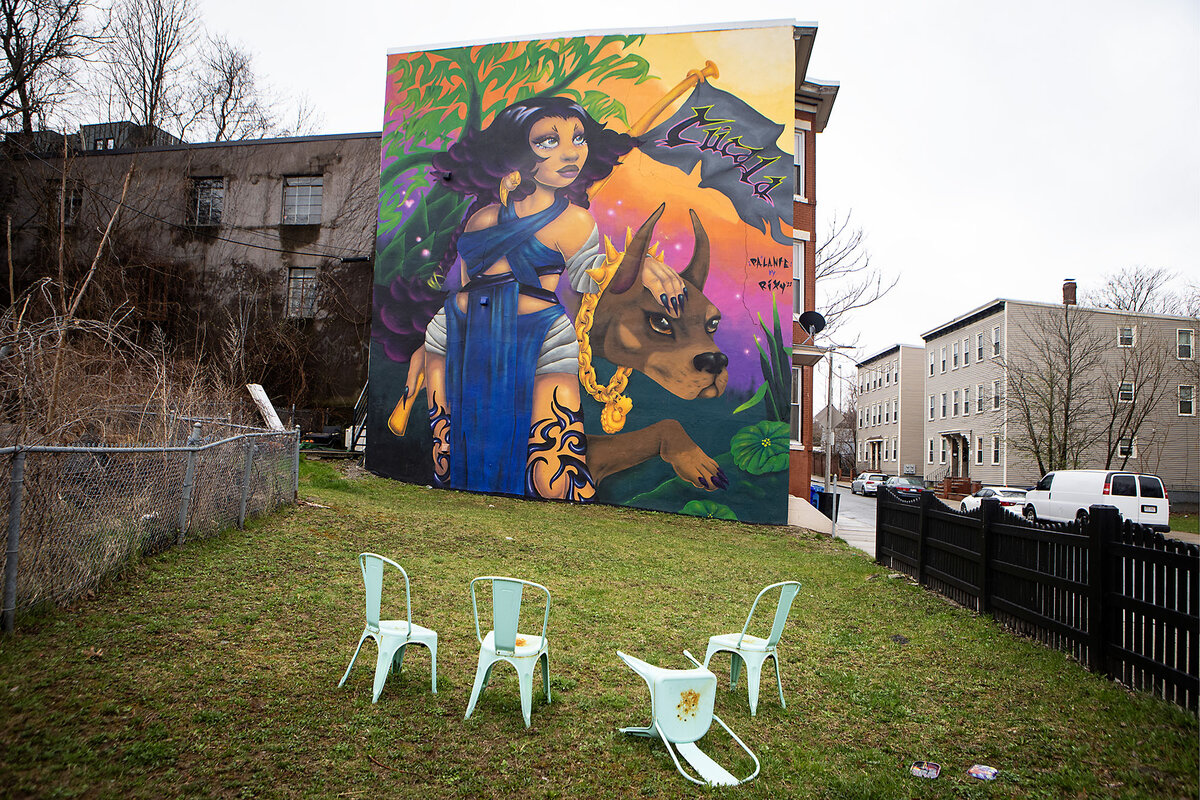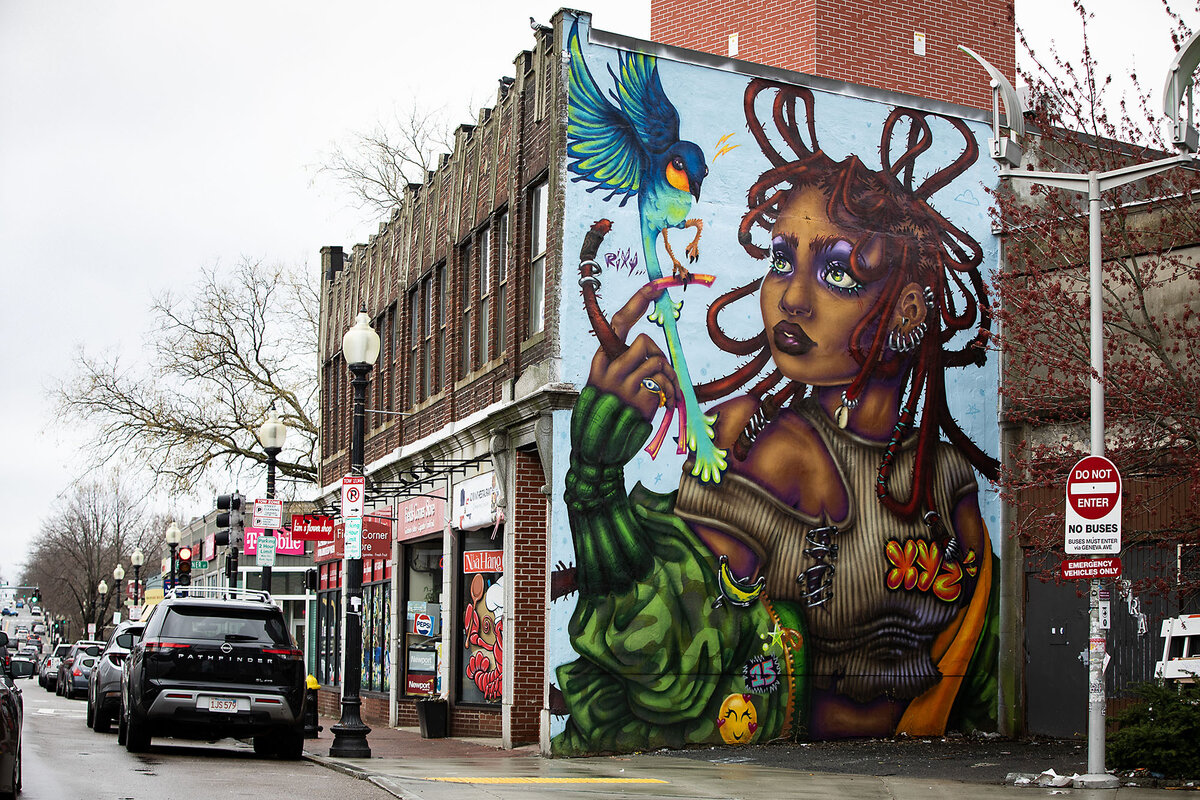This Boston artist creates murals that have a message: ‘We’re still here’
Loading...
| Boston
Rixy, an interdisciplinary street artist in Boston, describes herself as a vessel trying to capture community identity. “You’re a public artist,” she says about her process. “Your art is for the public.”
She says she wants to acknowledge and make space for the longtime residents of color in the city’s neighborhoods. “Roxbury is ... still so heavy with all of these cultures,” she says, citing one.
Why We Wrote This
A story focused onWhat role does public art play in communities? With buildings as her canvas, Boston muralist Rixy explores the intersection of art and identity.
Painting a three-story mural in that neighborhood took only four days, she says, but planning took a year. A lot of that included securing funding from grants and finding a scissor lift to borrow.
But it also took six months to win over Tina Andrews, the building’s owner, who finally agreed to a mural featuring a woman and a dog with long purple acrylic toenails. Originally, Rixy wanted to incorporate a cat, but Ms. Andrews doesn’t like cats.
In person and via texts and social media, Ms. Andrews says, people tell her “how much they love it.” “You wouldn’t believe,” she says, “people just getting out of their cars and walking up to the wall to look at it.”
When Rixy Fernandez grew up in Boston’s Roxbury neighborhood, her mother didn’t let her play outside. Highland Avenue was too dangerous. Two decades later, the interdisciplinary street artist has turned the city into her playground. Over the past several years, she has filled walls across Boston with vibrant, cartoon-inspired images.
Highland Avenue may feel safer these days, but the neighborhood is changing. More college students live here, as do young families and commuters. Rixy, as she is known professionally, wants to ensure the longtime residents who share her Latinx Caribbean background continue to see themselves reflected in her towering art.
“We’re still here,” she says, standing in a small patch of grass beneath one of her murals, covering the side of a three-story residential building in the neighborhood. “All these people can ... [see the] murals and come together, versus feeling like we need to erase you or you need to erase us.”
Why We Wrote This
A story focused onWhat role does public art play in communities? With buildings as her canvas, Boston muralist Rixy explores the intersection of art and identity.
That Highland Avenue mural, titled “Pa*Lante,” meaning “onward,” features an image of a woman and a dog against a colorful backdrop. Each of the eight paintings she’s created in the city is characterized by her signature style, which she describes as “sensual, powerful women of color” in an imaginative world. But each one also contains elements unique to the neighborhoods.
Rixy, who often relies on input from residents to come up with her designs, describes herself as a vessel trying to capture community identity – and then uses her paint to express it. “You’re a public artist,” she says about her artistic process. “Your art is for the public.”
The artist has exhibited in galleries from Massachusetts to California to the Dominican Republic. She has been an artist-in-residence at the Massachusetts Museum of Contemporary Art and at Elevated Thought, a Massachusetts-based group focused on art and social justice. She’s active in arts education and has taught at local institutions. Several of her murals have been commissioned by the city of Boston, including a portrait of Rita Hester, a Black transgender activist who was killed in 1998.
She created “Pa*Lante” when she was chosen for the Public Art Accelerator program from Now + There, now known as the Boston Public Art Triennial. To that organization, she represented the “character and tenacity and creativity of a local artist, especially a woman local artist, and a local artist of color,” says Jasper Sanchez, assistant curator with the Triennial.
Rixy’s artistic process begins with observation, even if that means just lying in the grass and watching the neighborhood bustle around her. “Are there schools? What are the closest restaurants? How can I use their culture a little bit more so they feel more represented?” she says. For example, a mural she painted in Cambridge, Massachusetts, includes fruit because it felt like an “artsy farmers market type of area.”
The artist’s work features characters that are part of an imaginative world she calls “Cúcala,” which signifies female empowerment and inclusivity.
A mural near the Fields Corner subway station in Dorchester, “Fly, Like You,” depicts a woman with a bright-green jacket and a blue-and-green bird on her finger. Rixy’s art often includes clothing inspired by video game characters, she says.
Back in Roxbury, she says she wants to acknowledge and make space for the longtime residents of color. She wants to remind people that “Roxbury is ... still so heavy with all of these cultures.”
Painting the three-story wall on Highland Avenue took only four days, Rixy says, but planning took a year. A lot of it was figuring out the logistics, including securing funding from grants and finding a scissor lift to borrow.
But it also took six months to win over Tina Andrews, the owner of the building, who finally agreed to turn one side of her house into a mural featuring a woman and a dog with long purple acrylic toenails. Originally, Rixy wanted to incorporate a cat, but Ms. Andrews doesn’t like cats.
The building owner says she has no regrets about her wall being turned into a mural.
In person and via texts and social media, Ms. Andrews says, people tell her “how much they love it.” “You wouldn’t believe,” she says, “people just getting out of their cars and walking up to the wall to look at it.”









